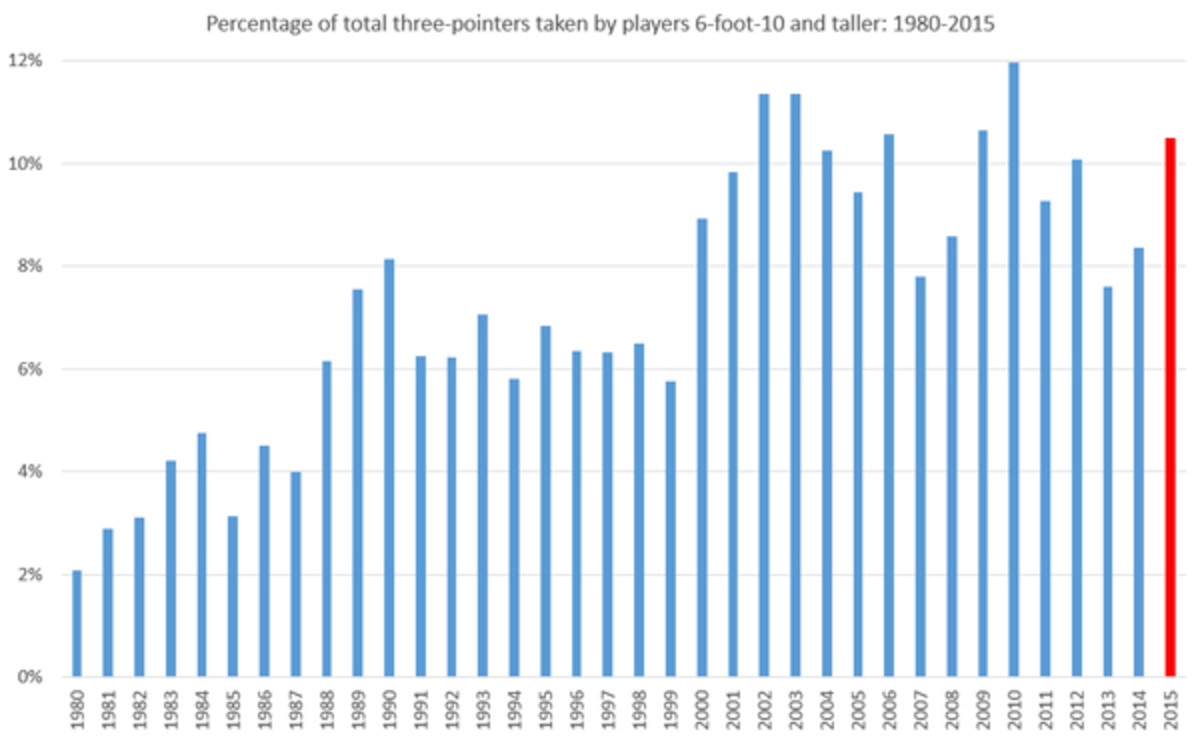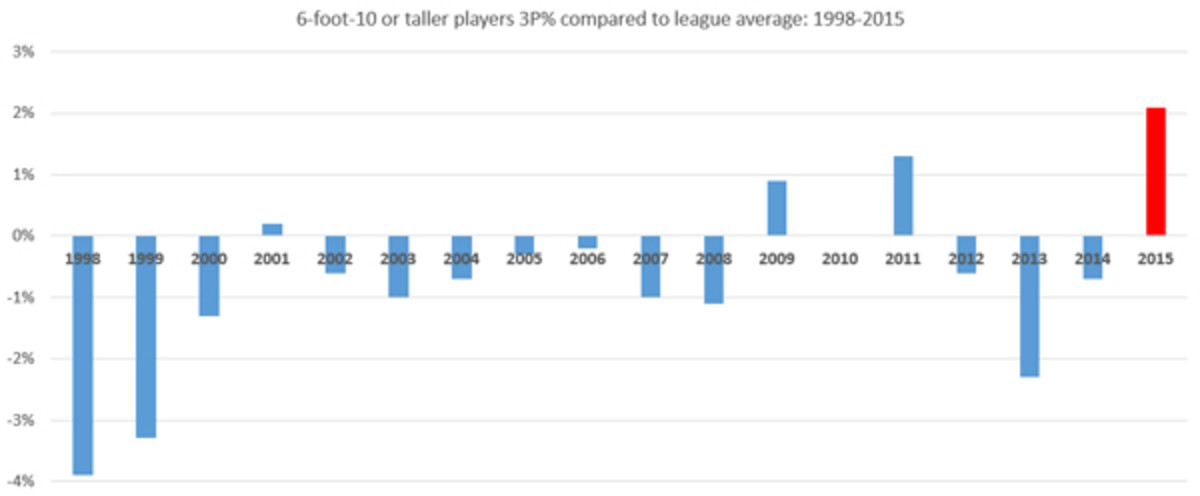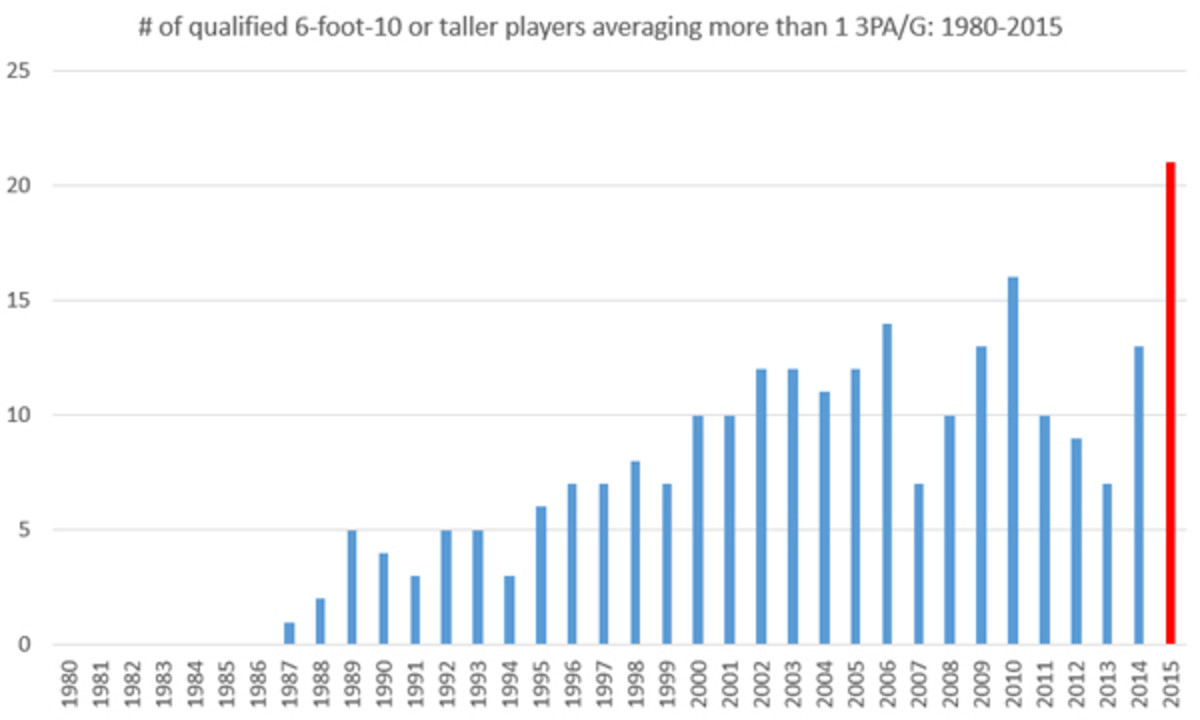Trends: Resurgence of stretch fours

In terms of pure intrigue and implications, it’s hard to top Monday night’s showdown between the NBA’s present (LeBron James) and future (Anthony Davis). The two All-Stars didn’t disappoint, as LeBron went for a triple-double in an entertaining victory while Davis stuffed the boxscore to the tune of 27 points, 14 rebounds, four assists, four steals and three blocks in a losing effort.
Still, Cavaliers-Pelicans also featured a stretch forward showdown that managed to be nearly as riveting as the headliners. Together, 6-foot-10 power forwards Ryan Anderson (New Orleans) and Kevin Love (Cleveland) scored 54 points while combining to hit 14-of-21 three-point attempts. Their marksmanship drove much of the game action: Anderson’s hot touch in the first-half helped New Orleans build a five-point halftime lead, while Love’s four fourth-quarter threes ensured that Cleveland would win going away.
• Play FanNation's new NBA games:Fast Break | BasketballThrowdown
Through the first two weeks of the season, Anderson and Love are hardly alone among big men when it comes to perimeter prowess. Instead, the first few weeks of the 2014-15 season have the makings of a revival for the “stretch forward” position. Mandatory sample size disclaimers apply -- given that we’re less than 10 percent of the way into through the season -- but the early data suggests that 2014-15 could go down as one of the best seasons ever for big men shooting from deep.
The Growth of the Stretch Forward
Lakers coach Byron Scott drew cave man comparisons for expressing his aversion to three-pointers. That's because the modern NBA looks nothing like it did when Scott's "Showtime" Lakers reigned supreme. Last season, NBA teams attempted a record 52,974 three-pointers; the league first cracked 10,000 threes in 1989, 20,000 threes in 1994 and 40,000 threes in 2007.
While You Weren't Watching: Rubio attacks, LeBron naps and more
The NBA’s general reluctance to shoot threes, once the line was implemented in 1979-80, was even more pronounced among its big men. In 1986-87, Tom Chambers made history: he became the first minutes-qualified player standing 6-foot-10 or taller to average at least one three-pointer per game. That’s right, there wasn’t a single big man to crack that modest standard for the first seven seasons that the three-point line existed. It wasn't until the 1987-88 season that players standing 6-foot-10 or taller attempted greater than five percent of all three-pointers. During the 1980s, the three-point line was basically an amusement park rollercoaster with a sign that read “must be shorter than 6-foot-10 to ride.”
(Note: from here on out, “bigs” will be used as shorthand for players who stand 6-foot-10 or taller. Also, thanks to Basketball-Reference.com for all stats and figured referenced below. Stats current through games played through Nov. 10.)
Although Toni Kukoc, Cliff Robinson, Matt Bullard, Terry Mills and others would shoot from distance with regularity throughout the 1990s, the tide change didn’t really begin for bigs until the turn of the century. In the 20 seasons prior to 1999-2000, bigs attempted greater than eight percent of all three-pointers just one time (1990); bigs have topped that mark in 13 of the 15 full seasons since and they are on track to do it again in 2014-15. Slowly, stretchy centers like Mehmet Okur, Spencer Hawes and Channing Frye began making regular appearances on the perimeter, allowing coaches to dream of distance shooting from all five positions thanks to slingshot-wielding Goliaths.

Click here to enlarge
What were the key drivers of this change? A list of explanations includes the following…
- Dirk Nowitzki proved once and for all that a big man could consistently hit from outside while taking a high volume of threes.
- The increasing globalization of the game brought in a greater number of basket-facing bigs who were comfortable shooting from distance.
- Rule changes to eliminate hand-checking made life easier for ball-handlers and, subsequently, created more drive-and-kick opportunities that made life easier for shooters.
- The “Seven Seconds or Less” Suns showed that an elite, three-heavy offense was capable of making noise consistently in the playoffs.
- Offenses evolved thanks to the greater implementation of efficiency-based strategies, as teams looked to generate shots at the rim, threes and free throws.
- Even more emphasis was placed on floor spacing once defenses began adapting to these changing approaches, resulting in premium contracts for big men who were capable of doing damage from outside.
- The three most recent champions – Dallas, Miami and San Antonio – have all made use of spread looks thanks to Nowitzki, Chris Bosh and Boris Diaw, thereby encouraging copycats.
Easier Said Than Done
Turning the theory behind a stretch big man into a functional reality is no easy task, as coaches have found out over the years. There’s a monster difference between 2009 Andrea Bargnani, who connected on a crisp 40.9 percent from deep, and the 2014 version, who bottomed out at just 27.8 percent. It also shouldn’t be a huge surprise that Byron Mullens is out of the league after chucking his way to a career 31.9 percent three-point shooting percentage with four teams in five seasons.
Open Floor: Thunder try to stay afloat, rebuilding Anthony Bennett and more
The gist of the dilemma: Bigs that merely take threes, and can’t make them, aren’t actually stretching anything. Collectively, players who are 6-foot-10 or taller have shot better than league average in just four of the 15 full seasons since 1999-2000. Where some coaches have crafted hard-to-guard lineups capable of lethal efficiency, others have found an unconventional approach that isn’t necessarily better than the old way, depending on the specific personnel available to them.

Click here to enlarge
Of course, this isn’t a simple plug-and-play situation. Even proven, elite shooters like Nowitzki can find themselves in mismatches on the defensive end, potentially limiting the net impact of their perimeter handiwork. Getting the most out of stretch bigs therefore usually requires multiple other hard-to-acquire pieces in place, like a rim-protecting center and a strong off-the-dribble guard. As stretch bigs have proliferated, teams have been forced to choose between making the most out of their current personnel or restructuring their roster compensation to take a new approach.
A Potential Resurgence
The NBA’s peak “stretch forward” season came in 2009-10, when players standing 6-foot-10 or taller accounted for a record 12 percent of all three-pointers attempted. This golden season saw Danilo Gallinari, Rashard Lewis, Frye, Troy Murphy, Andrea Bargnani, Rasheed Wallace, Hedo Turkoglu, and Charlie Villanueva each attempt more than 250 threes on the season. Remember when Chambers was the only big to attempt at least one three-pointer per game in 186-87? The 2009-10 season saw a record-high 16 different minutes-qualified players average at least one three. That year, more than than half the league’s teams had a big man capable of being a somewhat regular perimeter scoring option.
Since that high point, bigs have gravitated back toward the paint over last four years. Comparatively, bigs attempted a smaller share of the threes in 2012-13 (7.6 percent) and 2013-14 (8.4 percent); bigs have also connected at a below-average clip from outside in each of the last three seasons. Injuries (Gallinari, Anderson), age (Lewis, Murphy, Wallace, Turkoglu) and general attrition (Bargnani, Mullens, etc.) have all been contributing factors. It’s also possible that an increase in smaller lineups are by-passing big men that can stretch in favor of small forwards who can make due in the post.
Those developments appear to be reversing this season, at least so far. First, bigs have accounted for 10.5 percent of all attempted three-pointers, the highest mark since 2009-10 and up noticeably compared to each of the last two seasons. Second, bigs have connected on 36.6 percent of their attempts, which is 2.1 percent better than league average. If that relative mark were to hold -- which could prove difficult -- it would be by far the best collective shooting performance by bigs since the three-point line was returned to its current distance in 1997.
Klay Thompson's rare transformation helping Warriors take the next step
Anecdotally, there are all sorts of interesting cases helping to create this early-season turnaround. The 2014 playoffs certainly loom large: San Antonio’s excellence success with their spread looks, Indiana’s struggles with Atlanta’s spread approach, Miami’s ability to pose problems with Bosh’s increased three-point shooting, and Oklahoma City’s struggles to create spacing all provided ammo to decision-makers around the league.
For some, that meant investing long-term money or premium assets to acquire Love (Cavaliers), Hawes (Clippers) and Frye (Magic). For others, that meant encouraging existing shooters like Ibaka (Thunder) and LaMarcus Aldridge (Blazers) to lean more heavily on the three ball. Still others tapped international newcomers like Nikola Mirotic (Bulls) or Damjan Rudez (Pacers) to add a different wrinkle.
Perhaps most incredibly, new Jazz coach and former Spurs assistant Quin Synder has unleashed Enes Kanter on the outside. The 2011 lottery pick was drafted as a big-bodied, traditional low-post player, and he attempted just three three-pointers in more than 4,000 minutes over his first three seasons under former coach Tyrone Corbin. This year, Kanter has already attempted 11 threes in eight appearances with no sign of letting up.
All told, there are currently 21 players who are 6-foot-10 or taller that are averaging at least one three-point attempt per game, which would go down as a record if it continues.

Click here to enlarge
While the NBA’s grueling 82-game schedule, the potential for changing rotations and the difficulty of maintaining shooting percentages will likely pull that number down -- perhaps by quite a bit -- much of that list is in solid position to sustain its current production. In addition to some of the names mentioned above, younger guys in rebuilding situations like Kelly Olynyk (Celtics) and Brandon Davies (Sixers) have every reason to continue bombing with a permanent green light.
What Lies Ahead
The perimeter proof will really be in the pudding come playoff time. Here’s a quick rundown of spread options available to the top contenders: Spurs (Diaw), Clippers (Hawes), Warriors (Draymond Green in a smaller look), Blazers (Aldridge), Thunder (Ibaka), Mavericks (Nowitzki), Rockets (Terrence Jones and/or Donatas Motiejunas are being asked to step into that role), Cavaliers (Love), Bulls (Mirotic), Raptors (Patrick Patterson), Wizards (Drew Gooden, or Paul Pierce in a smaller lineup) and Heat (Bosh). Aside from Memphis, just about everyone else that matters can scale down or spread out if needed, and there is still plenty of time for fringe contenders to load up or make tweaks at the deadline.
Beating the Spurs at their own game would seem to be a difficult proposition, but it beats the demoralizing alternative that played out for the Blazers, Thunder and Heat last spring. Why let San Antonio trounce through another postseason without giving it a better shot?
The most compelling possibility, however, lies further in the future. On Monday, Anthony Davis attempted his first two three-pointers of the season, missing both. Just as Kevin Durant has evolved into an idealized and versatile high-volume/high-efficiency wing scorer, so too can Davis become an unprecedented, next-generation stretch forward. Forget about match-up problems: Davis is a Defensive Player of the Year talent capable of guarding multiple positions and switching effortlessly. Offensively, his mid-range game has made considerable progress in a short period of time and Davis plays above the rim and in traffic with ease. He has the length to shoot over defenders in the post and enough coordination to create a shot from the elbow.
So, what happens if and when Davis follows in the footsteps of Nowitzki, Love and Ibaka by fashioning a dependable three-point shot? What happens if “The Next Kevin Garnett” suddenly can pick-and-pop his way beyond the arc or float his way to the corner for short-porch threes? The world will find out soon enough. That future is coming.
